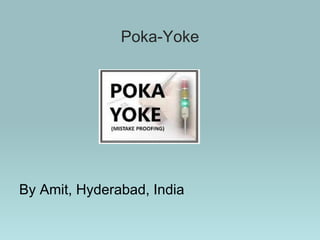
Poka yoke
- 1. Poka-Yoke By Amit, Hyderabad, India
- 2. What is Poka-Yoke? It is a Japanese term which means “Mistake-Proofing” It was originally known as Baka-Yoke, which means “Fool-Proofing” / “Idiot- Proofing” It is mostly implemented in Manufacturing Sectors
- 3. What is Poka-Yoke? It is a Japanese term which means “Mistake-Proofing” It was originally known as Baka-Yoke, which means “Fool-Proofing” / “Idiot- Proofing” It is mostly implemented in Manufacturing Sectors
- 4. History: This concept was first formalised and adopted by Shigeo Shingo in 1961 as part of the Toyota Production System Shigeo Shingo applied this to prevent human errors He recognised the concept of unavoidable human errors and defects in the production
- 5. Why Poka-Yoke? For operational excellence Can prevent errors from occurring in the first place If this is not possible, it performs a detective function, eliminating defects in the process as early as possible It ensures that proper conditions exist before actually executing a process step
- 6. What is Error? Error is a deviation from what is Correct, Right or True. Previously it was prevented by Scolding, Retraining or Telling them to be more careful. Now it is prevented by Training & Motivation.
- 7. How to use Poka-Yoke? Define the potential mistakes / errors List them which could be transferred to the next step Combine them with other tools such as Brainstorming
- 8. How to use Poka-Yoke? Identify Root Causes Investigate and analyze them Use other tools such as 5 WHYs for this step
- 9. How to use Poka-Yoke? Preparation: Completely prepare the team before they enter into the process Encounter: Protect the team who may misunderstand, ignore or forget their nature of the job or their role Resolution: Remind them of the value of their input to the continuous improvement of a service
- 10. How to use Poka-Yoke? Task: Focus on the common mistakes made while performing the task by the team Treatment: Focus on social interaction with them Tangible: Address the real, physical impression and experience for the team
- 11. Benefits of Poka-Yoke It helps people and processes work right the first time It is used to create a system that prevents defects from occurring It is used as a system to catch defects It refers to techniques that make it impossible to make mistakes Its basic concept is to avoid the problems by correcting the process
Notas del editor
- In 1963, a worker at Arakawa Body Company refused to use baka-yoke mechanisms in her work area, because of the term’s dishonourable and offensive connotation. Hence, the term was changed to poka-yoke, which means ‘mistake-proofing’.
- In 1963, a worker at Arakawa Body Company refused to use baka-yoke mechanisms in her work area, because of the term’s dishonourable and offensive connotation. Hence, the term was changed to poka-yoke, which means ‘mistake-proofing’.
- #3. Typo is an unavoidable human errors but it happens when we type by looking at the keyboard. Secondly, the text can be spell-checked before delivery.
- Tangible: physical, real, solid, concrete.